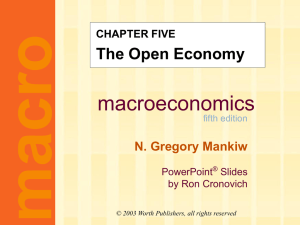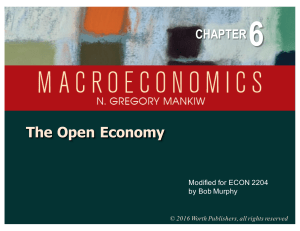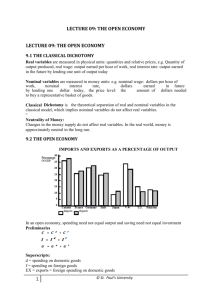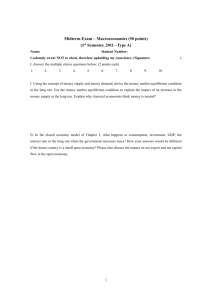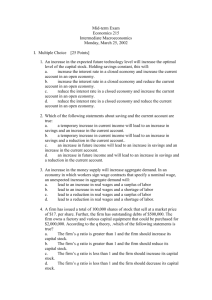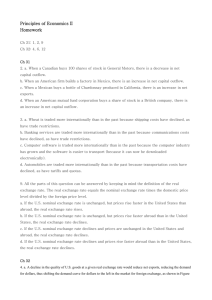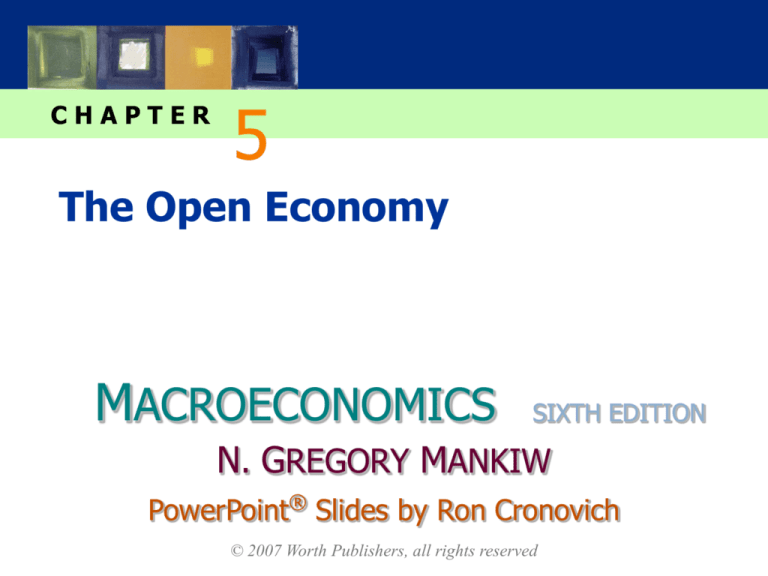
CHAPTER
5
The Open Economy
MACROECONOMICS
SIXTH EDITION
N. GREGORY MANKIW
PowerPoint® Slides by Ron Cronovich
© 2007 Worth Publishers, all rights reserved
In this chapter, you will learn…
accounting identities for the open economy
the small open economy model
what makes it “small”
how the trade balance and exchange rate are
determined
how policies affect trade balance & exchange
rate
CHAPTER 5
The Open Economy
slide 1
Trade-GDP ratio, selected countries, 2004
(Imports + Exports) as a percentage of GDP
Luxembourg
275.5%
Germany
71.1%
Ireland
150.9
Turkey
63.6
Czech Republic
143.0
Mexico
61.2
Hungary
134.5
Spain
55.6
Austria
97.1
United Kingdom
53.8
Switzerland
85.1
France
51.7
Sweden
83.8
Italy
50.0
Korea, Republic of
83.7
Australia
39.6
Poland
80.0
United States
25.4
Canada
73.1
Japan
24.4
CHAPTER 5
The Open Economy
slide 2
In an open economy,
spending need not equal output
saving need not equal investment
CHAPTER 5
The Open Economy
slide 3
Preliminaries
C C
d
C
d
f
I I I
f
G G d G f
superscripts:
d = spending on
domestic goods
f = spending on
foreign goods
EX = exports =
foreign spending on domestic goods
IM = imports = C f + I f + G f
= spending on foreign goods
NX = net exports (a.k.a. the “trade balance”)
= EX – IM
CHAPTER 5
The Open Economy
slide 4
GDP = expenditure on
domestically produced g & s
Y C d I d G d EX
f
f
f
(C C ) (I I ) (G G ) EX
C I G EX (C f I f G f )
C I G EX IM
C I G NX
CHAPTER 5
The Open Economy
slide 5
The national income identity
in an open economy
Y = C + I + G + NX
or,
NX = Y – (C + I + G )
domestic
spending
net exports
output
CHAPTER 5
The Open Economy
slide 6
Trade surpluses and deficits
NX = EX – IM = Y – (C + I + G )
trade surplus:
output > spending and exports > imports
Size of the trade surplus = NX
trade deficit:
spending > output and imports > exports
Size of the trade deficit = –NX
CHAPTER 5
The Open Economy
slide 7
U.S. net exports, 1950-2006
2%
0
0%
-200
-2%
-400
-4%
-600
-6%
-800
1950
-8%
1960
1970
NX ($ billions)
1980
1990
2000
NX (% of GDP)
percent of GDP
billions of dollars
200
U.S. Net Exports, 1950-2006
International capital flows
Net capital outflow
=S –I
= net outflow of “loanable funds”
= net purchases of foreign assets
the country’s purchases of foreign assets
minus foreign purchases of domestic assets
When S > I, country is a net lender
When S < I, country is a net borrower
CHAPTER 5
The Open Economy
slide 9
The link between trade & cap. flows
NX = Y – (C + I + G )
implies
NX = (Y – C – G ) – I
=
S
–
I
trade balance = net capital outflow
Thus,
a country with a trade deficit (NX < 0)
is a net borrower (S < I ).
CHAPTER 5
The Open Economy
slide 10
“The world’s largest debtor nation”
U.S. has had large trade deficits, been a
net borrower each year since the early 1980s.
As of 12/31/2005:
U.S. residents owned $10.0 trillion worth of
foreign assets
Foreigners owned $12.7 trillion worth of U.S.
assets
U.S. net indebtedness to rest of the world:
$2.7 trillion--higher than any other country,
hence U.S. is the “world’s largest debtor nation”
CHAPTER 5
The Open Economy
slide 11
Saving and investment
in a small open economy
An open-economy version of the loanable
funds model from Chapter 3.
Includes many of the same elements:
production function
consumption function
investment function
Y Y F (K , L )
C C (Y T )
I I (r )
exogenous policy variables G G , T T
CHAPTER 5
The Open Economy
slide 12
National saving:
The supply of loanable funds
r
S Y C (Y T ) G
As in Chapter 3,
national saving does
not depend on the
interest rate
S
CHAPTER 5
The Open Economy
S, I
slide 13
Assumptions re: Capital flows
a. domestic & foreign bonds are perfect substitutes
(same risk, maturity, etc.)
b. perfect capital mobility:
no restrictions on international trade in assets
c. economy is small:
cannot affect the world interest rate, denoted r*
a & b imply r = r*
c implies r* is exogenous
CHAPTER 5
The Open Economy
slide 14
Investment:
The demand for loanable funds
r
r*
Investment is still a
downward-sloping function
of the interest rate,
but the exogenous
world interest rate…
…determines the
country’s level of
investment.
I (r )
I (r* )
CHAPTER 5
The Open Economy
S, I
slide 15
If the economy were closed…
r
…the interest
rate would
adjust to
equate
investment
and saving:
S
rc
I (r )
I (rc )
S
CHAPTER 5
The Open Economy
S, I
slide 16
But in a small open economy…
the exogenous
world interest
rate determines
investment…
…and the
difference
between saving
and investment
determines net
capital outflow
and net exports
CHAPTER 5
r
S
NX
r*
rc
The Open Economy
I (r )
I1
S, I
slide 17
Next, three experiments:
1. Fiscal policy at home
2. Fiscal policy abroad
3. An increase in investment demand
CHAPTER 5
The Open Economy
slide 18
1. Fiscal policy at home
r
An increase in G
or decrease in T
reduces saving.
r
*
1
S 2 S1
NX2
NX1
Results:
I 0
I (r )
NX S 0
I1
CHAPTER 5
The Open Economy
S, I
slide 19
NX and the federal budget deficit
(% of GDP), 1960-2006
4%
8%
Budget deficit
(right scale)
2%
6%
4%
0%
2%
-2%
0%
-4%
Net exports
(left scale)
-2%
-6%
-4%
1960 1965 1970 1975 1980 1985 1990 1995 2000 2005
slide 20
2. Fiscal policy abroad
Expansionary
fiscal policy
abroad raises
the world
interest rate.
r
NX2
r2*
S1
NX1
r
*
1
Results:
I 0
I (r )
NX I 0
I (r )
*
2
CHAPTER 5
The Open Economy
I (r1* )
S, I
slide 21
3. An increase in investment demand
r
S
r*
EXERCISE:
Use the model to
determine the impact
of an increase in
investment demand
on NX, S, I, and
net capital outflow.
CHAPTER 5
The Open Economy
NX1
I (r )1
I1
S, I
slide 22
3. An increase in investment demand
r
ANSWERS:
I > 0,
S = 0,
net capital
outflow and
NX fall by the
amount I
S
NX2
r*
NX1
I (r )1
I1
CHAPTER 5
The Open Economy
I (r )2
I2
S, I
slide 23
The nominal exchange rate
e = nominal exchange rate,
the relative price of
domestic currency
in terms of foreign currency
(e.g. Yen per Dollar)
CHAPTER 5
The Open Economy
slide 24
A few exchange rates, as of 7/14/06
CHAPTER 5
country
exchange rate
Euro
0.79 Euro/$
Indonesia
9,105 Rupiahs/$
Japan
116.3 Yen/$
Mexico
11.0 Pesos/$
Russia
27.0 Rubles/$
South Africa
7.2 Rand/$
U.K.
0.54 Pounds/$
The Open Economy
slide 25
The real exchange rate
ε = real exchange rate,
the lowercase
Greek letter
epsilon
CHAPTER 5
the relative price of
domestic goods
in terms of foreign goods
(e.g. Japanese Big Macs per
U.S. Big Mac)
The Open Economy
slide 26
Understanding the units of ε
ε
e P
P *
(Yen per $) ($ per unit U.S. goods)
Yen per unit Japanese goods
Yen per unit U.S. goods
Yen per unit Japanese goods
Units of Japanese goods
per unit of U.S. goods
CHAPTER 5
The Open Economy
slide 27
~ McZample ~
one good: Big Mac
price in Japan:
P* = 200 Yen
price in USA:
P = $2.50
nominal exchange rate
e = 120 Yen/$
ε
e P
P*
120 $2.50
1.5
200 Yen
CHAPTER 5
The Open Economy
To buy a U.S. Big Mac,
someone from Japan
would have to pay an
amount that could buy
1.5 Japanese Big Macs.
slide 28
ε in the real world & our model
In the real world:
We can think of ε as the relative price of
a basket of domestic goods in terms of a
basket of foreign goods
In our macro model:
There’s just one good, “output.”
So ε is the relative price of one country’s
output in terms of the other country’s output
CHAPTER 5
The Open Economy
slide 29
How NX depends on ε
ε U.S. goods become more expensive
relative to foreign goods
EX, IM
NX
CHAPTER 5
The Open Economy
slide 30
U.S. net exports and the
real exchange rate, 1973-2006
140
Trade-weighted real
exchange rate index
2%
120
NX (% of GDP)
1%
100
0%
-1%
80
-2%
60
-3%
-4%
40
Net exports
(left scale)
-5%
20
-6%
-7%
1973
Index (March 1973 = 100)
3%
0
1977
CHAPTER 5
1981
1985
1989
The Open Economy
1993
1997
2001
2005
slide 31
The net exports function
The net exports function reflects this inverse
relationship between NX and ε :
NX = NX(ε )
CHAPTER 5
The Open Economy
slide 32
The NX curve for the U.S.
ε
When ε is
relatively low,
U.S. goods are
relatively
inexpensive
so U.S. net
exports will
be high
ε1
NX (ε)
0
CHAPTER 5
The Open Economy
NX(ε1)
NX
slide 33
The NX curve for the U.S.
ε
ε2
At high enough
values of ε,
U.S. goods become
so expensive that
we export
less than
we import
NX (ε)
NX(ε2)
CHAPTER 5
0
The Open Economy
NX
slide 34
How ε is determined
The accounting identity says NX = S – I
We saw earlier how S – I is determined:
S depends on domestic factors (output, fiscal
policy variables, etc)
I is determined by the world interest
rate r *
So, ε must adjust to ensure
NX (ε ) S I (r *)
CHAPTER 5
The Open Economy
slide 35
How ε is determined
Neither S nor I
depend on ε,
so the net capital
outflow curve is
vertical.
ε adjusts to
ε
ε1
equate NX
with net capital
outflow, S I.
CHAPTER 5
S 1 I (r *)
The Open Economy
NX(ε )
NX 1
NX
slide 36
Interpretation: Supply and demand
in the foreign exchange market
demand:
Foreigners need
dollars to buy
U.S. net exports.
ε
supply:
Net capital
outflow (S I )
is the supply of
dollars to be
invested abroad.
ε1
CHAPTER 5
The Open Economy
S 1 I (r *)
NX(ε )
NX 1
NX
slide 37
Next, four experiments:
1. Fiscal policy at home
2. Fiscal policy abroad
3. An increase in investment demand
4. Trade policy to restrict imports
CHAPTER 5
The Open Economy
slide 38
1. Fiscal policy at home
A fiscal expansion
reduces national
saving, net capital
outflow, and the
supply of dollars
in the foreign
exchange
market…
ε
S 1 I (r *)
ε2
ε1
…causing the real
exchange rate to
rise and NX to fall.
CHAPTER 5
S 2 I (r *)
The Open Economy
NX(ε )
NX 2
NX 1
NX
slide 39
2. Fiscal policy abroad
An increase in r*
reduces
investment,
increasing net
capital outflow
and the supply of
dollars in the
foreign exchange
market…
…causing the real
exchange rate to fall
and NX to rise.
CHAPTER 5
ε
S 1 I (r1 *)
S 1 I (r2 *)
ε1
ε2
The Open Economy
NX(ε )
NX 1
NX 2
NX
slide 40
3. Increase in investment demand
An increase in
investment
reduces net
capital outflow
and the supply
of dollars in the
foreign exchange
market…
…causing the
real exchange
rate to rise and
NX to fall.
CHAPTER 5
ε
S1 I 2
S1 I 1
ε2
ε1
The Open Economy
NX(ε )
NX 2
NX 1
NX
slide 41
4. Trade policy to restrict imports
At any given value of
ε
ε, an import quota
IM NX
demand for
ε2
dollars shifts
right
ε1
Trade policy doesn’t
affect S or I , so
capital flows and the
supply of dollars
remain fixed.
CHAPTER 5
The Open Economy
S I
NX (ε )2
NX (ε )1
NX1
NX
slide 42
4. Trade policy to restrict imports
Results:
ε > 0
(demand
increase)
NX = 0
(supply fixed)
IM < 0
(policy)
EX < 0
(rise in ε )
CHAPTER 5
ε
S I
ε2
ε1
The Open Economy
NX (ε )2
NX (ε )1
NX1
NX
slide 43
The determinants of the
nominal exchange rate
Start with the expression for the real exchange
rate:
e P
ε
P*
Solve for the nominal exchange rate:
P*
e ε
P
CHAPTER 5
The Open Economy
slide 44
The determinants of the
nominal exchange rate
So e depends on the real exchange rate and
the price levels at home and abroad…
…and we know how each
of them is determined:
M*
*
*
L
(
r
*
*,
Y
)
*
P
P*
e ε
P
NX (ε ) S I (r *)
CHAPTER 5
The Open Economy
M
L (r * , Y )
P
slide 45
The determinants of the
nominal exchange rate
P*
e ε
P
Rewrite this equation in growth rates
(see “arithmetic tricks for working with percentage
changes,” Chap 2 ):
e
e
ε
ε
P *
P*
P
P
ε
ε
*
For a given value of ε,
the growth rate of e equals the difference
between foreign and domestic inflation rates.
CHAPTER 5
The Open Economy
slide 46
Inflation differentials and nominal
exchange rates
35
Percentage
30
change in
nominal 25
exchange
20
rate
15
Mexico
Iceland
Singapore
10
South Africa
Canada
5
South Korea
_
0
U.K.
Japan
-5
-5
CHAPTER 5
0
5
The Open Economy
10
15
20
25
30
Inflation differential
slide 47
Purchasing Power Parity (PPP)
Two definitions:
A doctrine that states that goods must sell at the
same (currency-adjusted) price in all countries.
The nominal exchange rate adjusts to equalize
the cost of a basket of goods across countries.
Reasoning:
arbitrage, the law of one price
CHAPTER 5
The Open Economy
slide 48
Purchasing Power Parity (PPP)
PPP:
e P = P*
Cost of a basket of
domestic goods, in
foreign currency.
Cost of a basket of
foreign goods, in
foreign currency.
Cost of a basket of
domestic goods, in
domestic currency.
Solve for e : e = P*/ P
PPP implies that the nominal exchange rate
between two countries equals the ratio of the
countries’ price levels.
CHAPTER 5
The Open Economy
slide 49
Purchasing Power Parity (PPP)
If e = P*/P,
*
P
P
P
then ε e *
* 1
P
P
P
and the NX curve is horizontal:
ε
S I
ε =1
NX
Under PPP,
changes in
(S – I ) have no
impact on ε or e.
NX
CHAPTER 5
The Open Economy
slide 50
Does PPP hold in the real world?
No, for two reasons:
1. International arbitrage not possible.
nontraded goods
transportation costs
2. Different countries’ goods not perfect substitutes.
Nonetheless, PPP is a useful theory:
It’s simple & intuitive
In the real world, nominal exchange rates
tend toward their PPP values over the long run.
CHAPTER 5
The Open Economy
slide 51
CASE STUDY:
The Reagan deficits revisited
actual
1970s 1980s
change
closed
economy
small open
economy
G–T
2.2
3.9
S
19.6
17.4
r
1.1
6.3
no change
I
19.9
19.4
no change
NX
-0.3
-2.0
no change
ε
115.1
129.4
no change
Data: decade averages; all except r and ε are expressed as a percent of GDP;
ε is a trade-weighted index.
CHAPTER 5
The Open Economy
slide 52
The U.S. as a large open economy
So far, we’ve learned long-run models for
two extreme cases:
closed economy (chap. 3)
small open economy (chap. 5)
A large open economy – like the U.S. – falls
between these two extremes.
The results from large open economy analysis
are a mixture of the results for the
closed & small open economy cases.
For example…
CHAPTER 5
The Open Economy
slide 53
A fiscal expansion in three models
A fiscal expansion causes national saving to fall.
The effects of this depend on openness & size:
closed
economy
large open
economy
rises
rises, but not as much
as in closed economy
no
change
I
falls
falls, but not as much
as in closed economy
no
change
NX
no
change
falls, but not as much as
in small open economy
falls
r
CHAPTER 5
The Open Economy
small open
economy
slide 54
Chapter Summary
Net exports--the difference between
exports and imports
a country’s output (Y )
and its spending (C + I + G)
Net capital outflow equals
purchases of foreign assets
minus foreign purchases of the country’s assets
the difference between saving and investment
CHAPTER 5
The Open Economy
slide 55
Chapter Summary
National income accounts identities:
Y = C + I + G + NX
trade balance NX = S I net capital outflow
Impact of policies on NX :
NX increases if policy causes S to rise
or I to fall
NX does not change if policy affects
neither S nor I. Example: trade policy
CHAPTER 5
The Open Economy
slide 56
Chapter Summary
Exchange rates
nominal: the price of a country’s currency in
terms of another country’s currency
real: the price of a country’s goods in terms of
another country’s goods
The real exchange rate equals the nominal rate
times the ratio of prices of the two countries.
CHAPTER 5
The Open Economy
slide 57
Chapter Summary
How the real exchange rate is determined
NX depends negatively on the real exchange
rate, other things equal
The real exchange rate adjusts to equate
NX with net capital outflow
CHAPTER 5
The Open Economy
slide 58
Chapter Summary
How the nominal exchange rate is determined
e equals the real exchange rate times the
country’s price level relative to the foreign price
level.
For a given value of the real exchange rate, the
percentage change in the nominal exchange
rate equals the difference between the foreign &
domestic inflation rates.
CHAPTER 5
The Open Economy
slide 59

